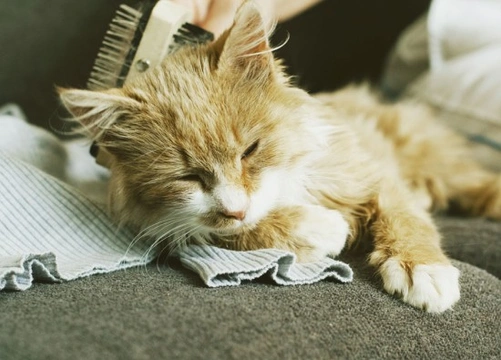
Cats and hairballs - Should you be concerned?
There is a certain sound that makes every cat owner roll their eyes and think ‘oh no!’ It is, of course, the inimitable noise of your cat coughing up a hairball and other assorted detritus all over the carpet, or worse still, your bed or sofa.Cat hairballs are undoubtedly annoying when regurgitated, and can cause staining and damage to carpet and fabrics- but other than being an inconvenience, are they cause for concern? Should you be worried about your cat developing hairballs, and is there anything you can do about it anyway? Read on to find out more!
What exactly is a hairball?
When your cat grooms their coat, they will naturally ingest a small amount of the fur that they lick. The tongue of the cat is very rough, and so naturally pulls loose hair away when they lick and groom themselves. The proportion of the hair that they ingest is actually fairly minimal, and the main part of that which they do ingest is passed naturally in faeces.However, on occasion, some of the hair that remains in the stomach forms a big matted knot, which is what we know as a hairball. Hairballs can actually be quite firm and hard if they have formed over a long period of time, and can potentially cause a blockage within your cat’s digestive tract or intestine.The vast majority of hairballs are regurgitated by your cat naturally, which is actually a good thing. A hairball in your cat’s vomit will generally be sausage-shaped rather than round, and normally dark in colour.It’s also worth noting that the common phrase ‘cough up a hairball’ is not technically correct, as while your cat may retch and cough as part of vomiting, they are not actually coughing the hairball out of their lungs, but from inside of their stomach.
Why do cats develop hairballs?
Most cats will fall victim to coughing up a hairball at some stage of their lives- this is simply because cats are fastidious about grooming themselves and will naturally ingest some of the hair that they groom when they do so.Cats that over-groom are particularly at risk of problematic hairballs, and longhaired cats are likely to develop hairballs with more regularity than their shorthaired counterparts are.A problem can potentially develop if your cat has a hairball in their stomach or intestine but is unable to regurgitate it themselves. In this case it can become hardened and form a blockage in the intestine, and would need to be removed by your vet.It is thought that grass eating in cats, which is something that most cats do now and then, is tied to their being able to regurgitate hairballs, and is actually a good thing and something that your cat simply knows is necessary now and then, so if you find your cat eating grass and later vomiting, don’t be too distressed!
How can suspected hairballs be treated?
If you are concerned that your cat has a hairball in their stomach that they are unable to pass naturally, it’s important to seek veterinary help right away. Your vet will perform some diagnostic tests and possibly an x-ray, to discern the presence of a hairball or other mass, and they may opt to remove it surgically or attempt to ease it’s passage by administering various medications.Some of the main signs and symptoms of a potentially problematic hairball in your cat include:
- Persistent vomiting, retching or coughing without a hairball coming up.
- Constipation.
- Lack of appetite.
- General depression.
- Lethargy and unwillingness to move about much.
- Discomfort in the stomach or abdomen area.
As ever, if you are in any doubt, consult your vet for advice.
How can I prevent my cat from developing hairballs?
Generally, you won’t need to do anything, as most cats manage their own hairballs without a problem. As mentioned, all cats will throw up a hairball every now and then, and this is fine and normal.However if your cat is regurgitating hairballs regularly, appears to be having problems bringing them up or has had previous issues with hairballs that have required veterinary treatment, you may wish to look at a few of the preventative measures you can take to minimise the chances of hairballs developing.
- Feed a special anti-hairball cat food, which your vet can advise you on. Anti-hairball diets are high in fibre, which minimises coat shedding and encourages your cat to pass any ingested fur naturally.
- Groom your cat’s coat on a daily basis to remove as much loose or shed hair as possible. This is particularly important with longhaired cats and around the changing of the seasons when cats naturally shed more.
- Consider using a special hairball treatment or supplement every now and then in consultation with your vet.
- Try to identify the root cause of the problem- often there is little you can do about your cat’s grooming habits, but keep an eye open for over grooming and try to identify the potential causes and so, solutions to this.
...And invest in a good quality, pet-safe carpet shampoo in the meantime!



